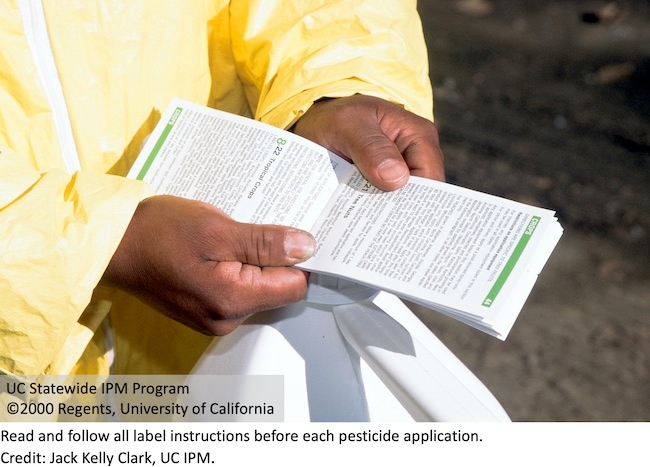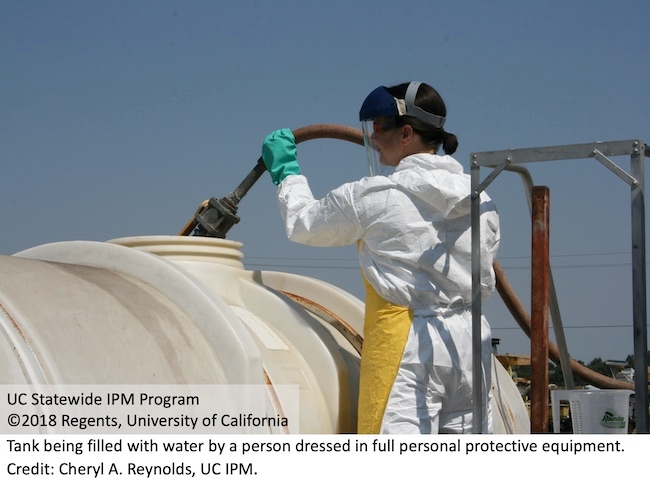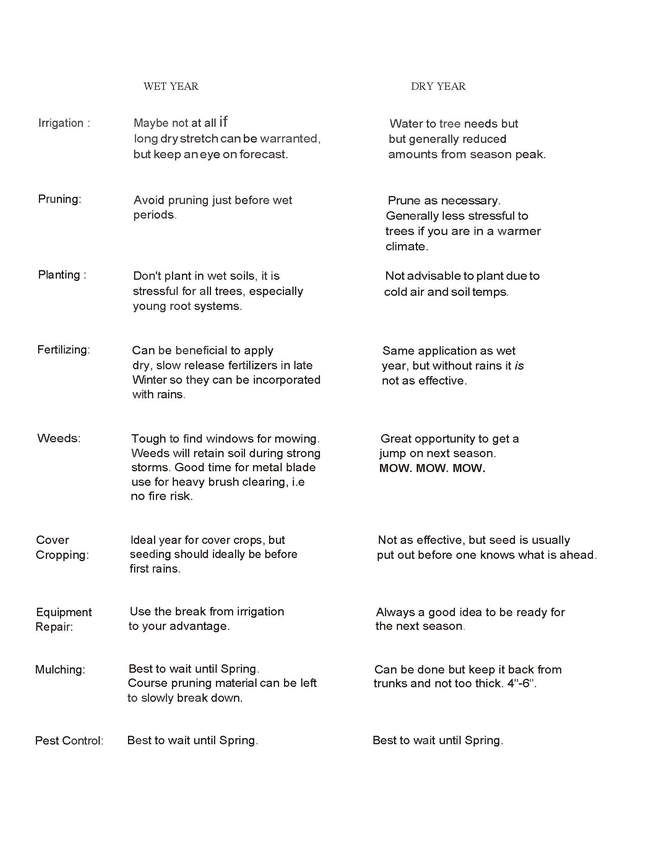
Posts Tagged: management
Winter Notes from an Organic Avocado Grower
By Shawn Martin, organic grower and CA Avocado Society Board member
It's never clear what winter will deliver to a coastal avocado grove on a steep slope, so the grower must be ready for whatever happens. And the main thing is rainfall. And Frost. And sometimes drought. And be ready for fire. And watch out for phytophthora. Some guidelines follow:

rain gauge
Don't - Suggestions for Avocado and Ctirus Growers
Ben Faber, Farm Advisor and Mary Lu Arpaia Extension Specialist
Sometimes growers respond to “DO's”. Do plant on mounds or berms, Do use avocado clonal rootstocks, etc. But sometimes we respond better to “DON'Ts”. Don't plant in wet soil. Don't bury the stem when planting. Don't apply foliar nutrients to avocado. So here, is a list of Don'ts that might make more of an impression than Do's. And some of the Don'ts are actually Do's, so read them well!
Prior to Planting
Don't do a soil analysis to determine suitability. You don't want to know what the pH is or salinity, or where a hard pan might be or areas of waterlogging or high winds. If you know before planting, you can make alternative arrangements, like correcting soil pH or leaching to correct salinity. That's too much work.
Don't chose an appropriate rootstock. Whether you are planning for citrus or avocado, select appropriate rootstocks for the site. Citrus has many more options than avocado, but even with avocado, some rootstocks are more tolerant of certain conditions, such as root rot, salinity and high pH.
Don't consider incorporating pollinizers in an avocado orchard. They might create more fruit.
At Planting
Don't plant on berms or mounds when there is potential for poor water or air drainage. Maintaining good water management which berms can help, can lead to the long-term health of the orchard.
Don't mulch at planting. This keeps weeds down, reduces evaporative loss and provides some control of avocado root rot.
After Planting
Don't control gophers and ground squirrels and rabbits and mice. They can be especially hard on young trees, but older citrus stems are always a sweet dessert for rodents.
Don't walk the orchard irrigation system, to check for leaks, breaks and non-uniformity.
Don't' have an irrigation system evaluation. It might point out how to better apply water and grow a healthy tree and more successful operation.
Don't prune, thin or manage tree height and size for optimum production.
Don't use irrigation in anticipation of and during frost or heat events.
Don't whitewash trees to prevent sunburn damage of exposed branches after heat or frost damage
Don't do fall leaf analysis to assess fertility needs and management
Don't walk your orchard to assess conditions and observe how harvest and pruning operations are progressing. Walking the orchard only at harvest time means if poor tree conditions have progressed it's harder to correct.
Don't do ground management with cover crops, mulch or various erosion control practices that lead to soil health.
Don't improve conditions for improved avocado pollination and fruit set. Consider promoting biological control through use of hedgerows, cover crops, pesticide use, fertility/pruning/irrigation and other horticultural practices.
Harvesting
Don't coordinate with your packer on the harvest; this might lead to better fruit quality and higher returns.
Don't pay attention to minimum maturity standards for citrus and avocado; they are just cumbersome regulations.
Don't worry about mixing avocado varieties in the bin, what is the consumer going to know or care?
Don't pay attention to the weather. Extremely hot weather coupled with delays delivering the fruit to the packinghouse may result in a loss of fruit quality and actual weight loss/size from the field to the packinghouse. Likewise, picking wet citrus can lead to peel disorders that only manifest after the fruit is packed.
Don't visit the picking crew while they are picking to inspect the quality of the harvesting job. What harm does a few long stems on citrus for instance do to fruit quality? Or if you are size picking to meet market demand, does it matter that there is a lot of undersized fruit?
These are all sarcastic Don'ts, but there are some real Don'ts that growers forget about:
Don't plant into wet soil. It leads to compaction and poor root growth.
Don't make a hole just as deep as the planting sleeve. Making a deeper hole can lead to the root ball settling and eventually covering the tree stem which can lead to stem cankers.
Don't incorporate an organic planting mix. This leads to decomposition and eventual settling of the material around the football and the stem getting buried.
Don't let the mulch accumulate around the trunk, leading to crown rot.
Don't let mulch fall into planting hole. Same as incorporating in the planting media.
Don't incorporate a fertilizer in the planting hole. The tree is loaded from the nursery and there is a good chance of burning the roots.
Don't spray when wind speeds exceed 10 mph If you are spraying pesticides, no matter how close you are to finishing or how little is still left in the tank. Famous good intentions that backfire.
And for those who prefer a more positive approach, using Do's, here's another way of listing field activities. Remember that every situation is different and avocados may be more sensitive to some of these Do's than citrus and other deeper-rooted trees crops. So said another way:
Do soil testing prior to planting.
Do choose appropriate rootstocks.
Do mulch at planting, keeping it away from the tree stem and don't incorporate an organic planting mix in the hole.
Do incorporate pollinizers.
On flat ground, shallow ground, Do plant on berms or mounds, especially avocados.
Do make a hole no deeper than the root ball and make sure it's not sloppy wet when digging and don't backfill with organic planting mix. Use the native soil. And don't put fertilizer in the planting hole.
Do mulch trees, especially avocados.
Do control rodents, especially in citrus and young trees. But even mature citrus can collapse in a weekend of gopher feeding.
Do an irrigation system evaluation and walk your irrigation lines frequently.
Do maintain tree size, preventing tree shading of neighboring trees and self-shading.
Do use irrigation system for winter warming and cooling during heat spells.
Do whitewash trees after defoliation to prevent sunburn damage.
Do leaf analysis to optimize fertilizer applications.
Do walk the orchard to evaluate conditions before they get worse.
Do make pesticide applications following all guidelines.
Do optimize the orchard for biological control, soil health and tree performance by keeping as much of the ground covered with mulch or cover crop, and including alternative pollen and nectar sources from hedgerows.
Do make sure the trees and orchard are getting the right amount and timing of as good a quality of water as possible.
Do coordinate with your packer on timing of harvest and delivery to the packinghouse to optimize fruit quality. You don't know where your fruit is going to go in the national and international market and it is important that we all do our part to maintain the excellent reputation of California citrus and avocado.
Do pay attention to fruit seasonality and variances between growing seasons. Paying attention to the market while picking fruit of optimal quality is an important balancing act. Don't play the late market unless you can actually hold your fruit late.
Do pay attention to weather when you are planning harvests. Keep in mind that the fruit are living and will respire and lose moisture. Keeping fruit in the shade will minimize weight loss before transport to the packing house. Keep the time in the field after harvest to a minimum.
Do inspect the harvested fruit before it leaves your grove. Make sure that stems are short and will not cause puncture wounds (= decay) on adjacent fruit. Make sure you are not mixing avocado varieties in the bin since they will likely be graded out at the packinghouse anyway and will at the least result in an uneven looking packed box.
There are so many Don'ts that it's hard to list them all. The best is this one:
The last Don't is, don't attend grower meetings like those sponsored by CA Citrus Research Board, CA Avocado Society, CA Avocado Commission, CA Assocation of Pest Control Advisers, Pesticide Applicators Professional Association, Groundwater Management group or other grower organizations. Don't stop learning.
If you have some other outstanding Don'ts, Do pass them on to me. Do continue learning and being inquisitive.

dead leaf blight
Pest Control in South Africa
South Africa is a known exporter of subtropical fruit (avocado, litchi and mango). The main production areas for subtropical fruit in South Africa are parts of Limpopo, Mpumalanga and KwaZulu-Natal. The avocado and litchi industries are export orientated while the majority of mangoes produced are processed. The main export markets are the European Union and the United Kingdom. Subtropical fruit production is susceptible to various insect pests that significantly contribute to yield losses. Twenty years ago mainly broad spectrum insecticides (organophosphates and pyrethroids) had been registered for control of pests and progress was made in adopting eco-friendlier management approaches. The lowering of maximum residue levels for pesticides on food products by importing countries provide new challenges for growers. Here, details are provided on the important insect pests of subtropical crops and the current management strategies use for controlling these pests. An integrated pest management strategy should aim to use interventions that lower maximum residue levels. A challenge that still remains is the sucking bug complex on avocado and more environmentally friendly strategies used for suppression need to be developed. An effective trapping system to monitor adult sucking bugs coming into the orchards will be important for effective management. Challenges that still remain are the litchi moth, Cryptophlebia peltastica (Meyrick) (Lepidoptera: Tortricidae) on litchi, and the citrus thrips, Scirtothrips aurantii Faure (Thysanoptera: Thripidae) and the mango seed weevil, Sternochetus mangiferae (Fabricius) (Coleoptera: Curculionidae) on mango. The development and testing of mating disruption products, attract and kill products, and biological control products for litchi moth is important. Biological control products also need to be tested against citrus thrips on mango. The mango industry needs to find more environmentally safe suppression methods that can be used with sanitation to manage mango seed weevil as it is a pest of phytosanitary concern. The set of economic thresholds for the important pests also need some attention. The use of botanical pesticides has not yet been tested on a large scale and could possibly contribute to the control of pests in the future.

avocado seed husk
February Is Safe Pesticide Use Month
Author: Petr Kosina, UC Statewide IPM Program
To raise awareness of pesticide safety practices, February is celebrated as National Safety Education Month. This year the University of California Statewide Integrated Pest Management Program offers help to refresh your knowledge about safe and effective pesticide use. Two frequently sought-after online courses focused on proper pesticide use to avoid illegal residues and proper selection, use, and removal of personal protective equipment are offered for free during the month of February. Use code safety100 at checkout to get your continuing education units (CEU) for free.
Pesticides are among the most regulated chemicals in the country. In the United States, the Environmental Protection Agency (EPA) regulates the use of pesticides. All pesticides must be registered with the EPA, and the agency requires a battery of scientific tests to determine the potential risk to humans and the environment. 
Best practices for using pesticides safely start with reading the label before each pesticide application. How will readingthe label help you? Pesticide labels answer most of the basic questions you need to know about the product, its safe application and handling. Always make applications in strict accordance with all label instructions. Following label instructions will ensure safe, effective, and cost-effective use of the pesticide. Apart from the label, it is important to know what your state regulations are because some state regulations that also have to be observed are not written into the label. Note that not all pesticides approved by the EPA and available for purchase in the United States can be used in California. California is one of the few states that have more strict pesticide regulations for certain pesticides than what is required by the EPA. Even if you have used a given pesticide in the past, make sure you have an up-to-date label, as EPA may occasionally change labels. To learn more about pesticide labels and how to extract information relevant to the specific setting and situation in order to apply pesticides safely, enroll in the online course Proper Pesticide Use to Avoid Illegal Residues. Pest management professionals will earn 2.0 hours of Laws & Regs CEUs.
Because pesticides have the potential to cause injury or illness to anyone working with them, it is important to wear personal protective equipment, or PPE, to reduce a person's exposure to pesticides. PPE includes clothing and certain devices worn to protect the human body from contact with pesticides or pesticide residues. Regular clothing is not considered PPE even though some pesticide labels may indicate that these specific items of regular work clothes can be worn during certain activities. All employees who handle pesticides in California are legally required to wear PPE. They must follow all PPE instructions on the pesticide label and follow all California laws and regulations. To learn how to select the proper PPE, use it, remove it, and dispose of it or clean and store it before, during, and after each incidence of pesticide handling and application, enroll in the online course Proper Selection, Use, and Removal of Personal Protective Equipment (PPE). Pest management professionals will earn 1.5 hours of Laws & Regs CEUs.
Visit the UC IPM website to see all 22 online courses that are available for continuing education credit.
Diagnosing Herbicide Injury- New Online Course
Written By--Petr Kosina, UC Statewide IPM Program A brand-new online course on Diagnosing Herbicide Injury focusing on how an herbicide injury situation can arise, what information can help diagnose symptoms during field...

